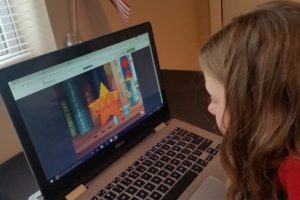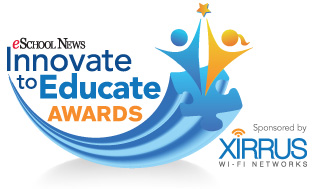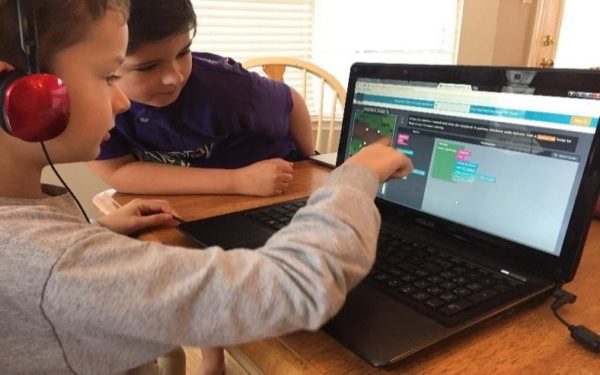Innovation doesn’t simply involve throwing technology into a classroom. It requires unconventional ideas, foresight, thoughtfulness, and dedication to student learning. And as the world becomes more connected, schools are making every attempt to help students develop the skills they’ll need to be a part of that interconnected world.
In the Florida Virtual School (FLVS), students are learning in unique ways while developing these much-needed skills through individualized and personalized learning methods, said Sarah Sprinkel, FLVS elementary principal.
FLVS is one of two Community Winners in the eSchool Media and Xirrus Innovate to Educate awards program, which recognizes the unique ways schools and districts are leveraging technology to improve student learning.
Sprinkel’s expertise spans 35 years in education, and she retired more than once when she had what she described as “a wonderful opportunity to learn what was going on in the virtual world.”
Her past experience in child development involves using observations about how children learn to form standards and course requirements. FLVS leaders wanted to see if she could do that, and develop best practices, in the virtual world.
“I was always the go-to person who made sure the practices our teachers used were developmentally appropriate,” Sprinkel said. “People used to talk about developmentally-appropriate practices as though they weren’t good. But it simply means that if you teach kids the way they learn, they’re going to learn.”
FLVS implemented a strategy called ClassTime, which uses live video lessons that require students and teachers to work as a class in a blended learning environment online twice a week. Students work independently with their parents three times a week.
Students interact online by participating in class discussions, sharing information, answering questions and working as a class with teachers. The strategy keeps students engaged with approaches such as voting tools, chat boxes and breakout rooms.
(Next page: Overcoming virtual challenges to ensure student success)
In order to help students learn together and learn as much as possible, FLVS leaders purchased cameras, writing tools, and other devices to make sure teachers could present things such as science experiments as well as deliver discussion-based assessments online.
Teachers make every effort to personalize learning for students, including assignments that are individualized and tailored to a student’s specific needs, or breakout rooms where students gather online in smaller groups to work on assignments.
“We’ve taken the tools we have through virtual delivery and we’ve put a very high-quality teacher with those tools, and we’ve gotten the best of both worlds,” Sprinkel said. “It’s amazing how the students believe the teacher is talking just to them. They feel very individualized.”
Teachers also strive to incorporate as many modalities as possible in every lesson. “The more you can involve all your modalities—vision, hearing, doing things in a kinesthetic manner—our lessons involve many modalities. That’s optimum learning,” Sprinkel said.
“We have some of the finest teachers in the world,” she added. “They’re the difference makers. They’re the ones who do this all the time.”
The data coming from online tools enhances the instruction students receive, she said.
“A teacher cannot discover as quickly as a personalized system when a child is ready to move to the next level,” Sprinkel said. “When the analytics allow that—wow!”
Meeting virtual challenges
 As with every new initiative, ClassTime didn’t come without challenges.
As with every new initiative, ClassTime didn’t come without challenges.
Skeptics might wonder how an online learning program helps students work on interpersonal skills and develop relationships, but FLVS educators work hard to maintain those relationships with their students.
“Best practices in education, for kindergarten, include developing relationships first,” Sprinkel said. “We know developing relationships is important. For every lesson, the first thing we do is have an engagement activity—you have something to make sure relationships are developed.”
Adequate hardware and software are also necessary so the technology used on the school’s end is actually available to the students. For instance, Sprinkel said, showing a video that students can’t view due to outdated or absent technology on their end will not work. Many alternatives have to be provided for students who have outdated access to technology.
For instance, if a student cannot watch a video, alternatives are provided. FLVS teachers always put the video link in the chat box for students to access at a later date, and it is included in students’ written assignments. But in case that does not work, teachers describe the video and/or provide an alternative lesson that teaches the same concept.
Ensuring success
 When it comes to three components that helped technology innovation succeed at FLVS, Sprinkel said:
When it comes to three components that helped technology innovation succeed at FLVS, Sprinkel said:
- It is imperative that the attitude of teachers, staff, students and families are that this approach will work. However, it will take adjustments since it is a non-traditional delivery method.
- Adequate hardware and software are also necessary so the technology used is actually available to the users. Showing a video that students are not able to view does not work. Many alternatives have to be provided for students who have outdated access to technology.
- We will benefit from continued innovation to better involve students in the process since many platforms do not provide enough interactives for young students.
Part of the initiative’s success is due to the “why” behind it, Sprinkel said. “The popularity is because we are doing what every teacher out there wants to do—we are meeting the needs of students.”
Establishing best practices for classroom delivery at the elementary level is an evolving process, she added.
“We didn’t do anything with the idea that it was set in stone,” Sprinkel said. “Whatever our program looks like in the next 10 years, it will continue to evolve and change—but it will evolve and change with students, and that’s what is so powerful about it.”
 [Editor’s note: This story is part of the eSchool News Innovate to Educate Awards program, sponsored by Xirrus. The awards program recognized the country’s finest ed-tech initiatives and offered schools and districts across the U.S. the opportunity to showcase their groundbreaking approach to improving teaching and learning through the use of technology.]
[Editor’s note: This story is part of the eSchool News Innovate to Educate Awards program, sponsored by Xirrus. The awards program recognized the country’s finest ed-tech initiatives and offered schools and districts across the U.S. the opportunity to showcase their groundbreaking approach to improving teaching and learning through the use of technology.]
- 4 ways to support work-based learning - April 23, 2024
- Prioritizing inclusivity in game-based learning - April 22, 2024
- Friday 5: Universal Design for Learning - April 19, 2024


